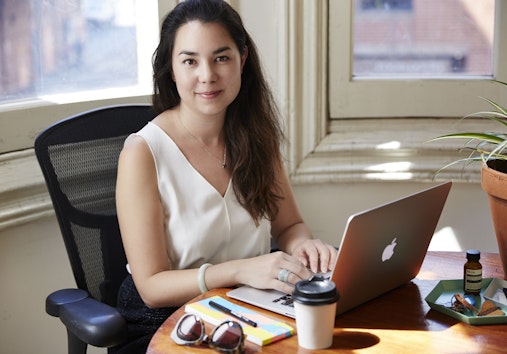Narratives thwarted: Tokyo and New York take on art from Southeast Asia
Mikala Tai
There is a sense of interminable temporality for a region that perches on some of the most active seismic territory in the world. Southeast Asia balances on the Sunda plate at the collision point of the Alpide belt and the Pacific Ring of Fire where it is characterised by topographical shifts and the heavy weight of humidity. Home to roughly one tenth of the world’s population, the tiny tracts of land that comprise the region are collections of islands and tapered peninsulas. Here, in the climactic band of the tropics, are some of the most dynamic and diverse cultures.
Southeast Asia is nestled between the Indian and Pacific oceans on rich volcanic earth and is home to some of the world’s most sought after resources. From as early as the sixteenth-century European traders came in search of cinnamon, nutmeg, mace and sea cucumbers, bringing with them new languages, cultures, technologies and religions. With such fertile land the traders quickly turned colonialists, carving pockets of picturesque oases for their own empires. This region was termed ‘Southeast Asia’ by Western military strategists during the Second World War that acknowledged the shared history of colonial and Japanese occupation as its own geographic entity (1). Since then, this term has become the overarching descriptor for the mainland countries that reside on the peninsula between India and China—Cambodia, Laos, Malaysia, Myanmar, Singapore, Thailand and Vietnam—as well as the maritime islands of Brunei, Indonesia, Philippines and Timor Leste that stretch between Australia and Japan.
In the height of summer, the intensity of the tropics moves north. It creeps up from the equator, oppressively encapsulating cities with the hot and sticky heat of humidity. For just a few weeks Tokyo and New York are plunged into these climate conditions and, in 2017, the winds from down south also ushered in two milestone exhibitions of art from Southeast Asia. In Tokyo, a collaboration between the National Art Centre, Mori Art Museum and the Japan Foundation Asia Centre saw the presentation of SUNSHOWER: Contemporary Art from Southeast Asia 1980s to Now that included the work of 86 artists from across the region. Significantly, Mori’s undertaking heralded the largest exhibition of Southeast Asian contemporary art to ever be exhibited in Japan and commemorated the fiftieth anniversary of the Association of Southeast Asian Nations (ASEAN). In New York, the Asia Society Museum’s more compact exhibition, After Darkness: Southeast Asian Art in the Wake of History, featured the work of only eight artists. These exhibitions signalled a recognition of the breadth and dynamism of contemporary cultural art of the region as much as they evidenced the recasting of relationships between Japan and the United States with Southeast Asia.
Historically, the Southeast Asian region is characterised by upheaval and occupation. Of the eleven countries that comprise Southeast Asia only Thailand escaped European colonialism. The trade routes and ocean winds blew Portuguese, Spanish, Dutch, French, British and American colonialists into the region where they settled in coastal towns to trade and then quickly expanded to settlements claiming land as their own. Colonialism began as early as 1511 in Malaysia and resulted in Southeast Asia being shaped politically and culturally by Western influences that remain tangible in architectural remains and cultural traditions. For many of these countries it was Japanese forces in the Second World War that ended European colonialism: taken with brute force, the Japanese occupied the entirety of South East Asia, with only Thailand spared, forging a somewhat precarious treaty to be allies of convenience (2). With deft speed and unexpected ease the Japanese dismantled the European stronghold of Southeast Asia in a matter of weeks, eradicating centuries of occupation and, particularly in the case of the ‘fall’ of Singapore, humiliating empires and their façade of military might. For a brief time until the end of the Second World War, Japan had the largest historic Asian empire which dissolved instantly at the end of the war, ushering in the Modern era of the region.
Historically, the Southeast Asian region is characterised by upheaval and occupation. Of the eleven countries that comprise Southeast Asia only Thailand escaped European colonialism.
Modern history of Southeast Asia is characterised by nation-building, fraught negotiations of independence, civil wars and devastating political wars, alongside extraordinary economic growth. Vietnam, Cambodia and Laos were beamed into global consciousness in the Second Indochina War where the geopolitical tensions of the Cold War played out in bloody and uncompromising devastation. Allied involvement spearheaded by the Americans was underpinned by a fear that Communism from Northern Vietnam and China would creep uncontrollably through South East Asia and required swift containment. In the decades since the fall of Saigon on 30 April 1975 the war remains a political flashpoint, seared into lived memories as an interminable twenty year war (or thirty if one includes the First Indochina War that immediately preceded it) that, with deaths calculated up to 4 million, was far from cold (3).
For Japan and the United States, both of whom played pivotal roles in recent wars and conflicts throughout Southeast Asia, these exhibitions are significant in their attempts to reimagine the role and relationship they have with the region. From Vietnam to the Philippines, the legacy of such occupations are palpable; significant physical and emotive scars remain as lived experience for some and as intergenerational trauma for younger generations. What makes SUNSHOWER and After Darkness provocative and enthralling exhibitions is that they seek to curatorially acknowledge the role each of their respective host nations have played in the region. Such acknowledgement is presented through a series of works that speak to the vast and complex dimensions of trauma that critically question political acts of remembrance and memorialisation while challenging the viewer to reimagine accept ‘truths’ of history.
The Mori Museum sits on the top of a 54-storey building in Tokyo’s Roppongi Hills surveying the metropolis through windows that offer glimpses of the outside world. Travelling from a shopping centre through pristine lift systems to arrive at an escalator into an architectural wonder in the sky, the galleries of the Mori Museum could not be further from the pulsating, dusty streets of Southeast Asia. Renowned for its ongoing series of temporary contemporary exhibitions, since 2003 Mori has been a destination museum of the city. The privately owned museum is architecturally intriguing and has actively sought to create ‘a place where what is important in our culture and society is openly debated’ (4). While past Mori exhibitions have profiled leading global artists as Takashi Murakami (2015), Lee Bul (2012) and Ai Weiwei (2009) via significant retrospectives, the Museum’s thematic exhibitions have sought to elucidate discussion through curatorial provocations. The Mori Museum has examined the future of cities in Metabolism: The City of the Future (2011), the intersection of creativity and science in Medicine and Art: Imagining a Future for Life and Love (2009) and, in the museum’s inaugural exhibition, Happiness: A Survival Guide for Art and Life (2003). Spearheading SUNSHOWER represents the most ambitious continuation of curatorial enquiry yet for the Museum.
SUNSHOWER builds on several exhibitions of contemporary Southeast Asian art presented in Japan but, for the first time, engages with the complex modern history of the region acknowledging the influence Japan has played. Tracing three decades of artistic contribution the exhibition marks the occasion of the fiftieth anniversary of ASEAN and is realised through a collaborative partnership between the Mori Museum and the National Art Center, a government institution with large cavernous halls set on the grounds of the old University of Tokyo, alongside exhibition partner the Japan Foundation Asia Center. Anchored by the Japanese government, this large-scale exhibition represents an important gesture of sensitivity where the sentiment to learn ‘deeply through contemporary art’ from Southeast Asia is given the discursive weight of being ‘a valuable opportunity for understanding better how we can live together in the times to come’ (5). This curatorial framework aligns Japan to a shared future with Southeast Asia and in this sense SUNSHOWER takes a valuable step towards publically acknowledging Japan’s forceful role in the region during wartime and beyond.
Presented as a series of questions, SUNSHOWER delves into nine threads of contemporary concerns arriving at a final series of works under the heading of ‘Dialogue with History.’ Exemplary works preface this final encounter by some of Southeast Asia’s luminaries: Melati Suryodarmo, Dinh Q. Le, Manuel Ocampo and Tiffany Chung who present considered and critical works that are continuations of their global practices. Their contributions are erudite investigations of migration, historical interpretations, and the intimate personal experience of living through vast change. The works by these artists address a gap in the historical consciousness of Japan where, post-1945, the modern history of Southeast Asia was barely registered (6). Their inclusion is a curatorial gesture of rehistorisation on its own. There is also a sense of playfulness to the curatorship, where younger artists such as Cambodia’s Tith Kanitha and Indonesia’s Fajar Abadi RDP and Anggun Priambodo bring the noise and dynamism of the roadside into the confines of the white cube. Within this context, works by these artists expand ideas of art and art practice and encapsulate the intertwining of art and the everyday that is prevalent in the region. However, it is in the final section presented at the Mori Museum where SUNSHOWER pushes beyond a pulse check exhibition of the region and engages directly with the complex history of the region that Japan is so connected with.
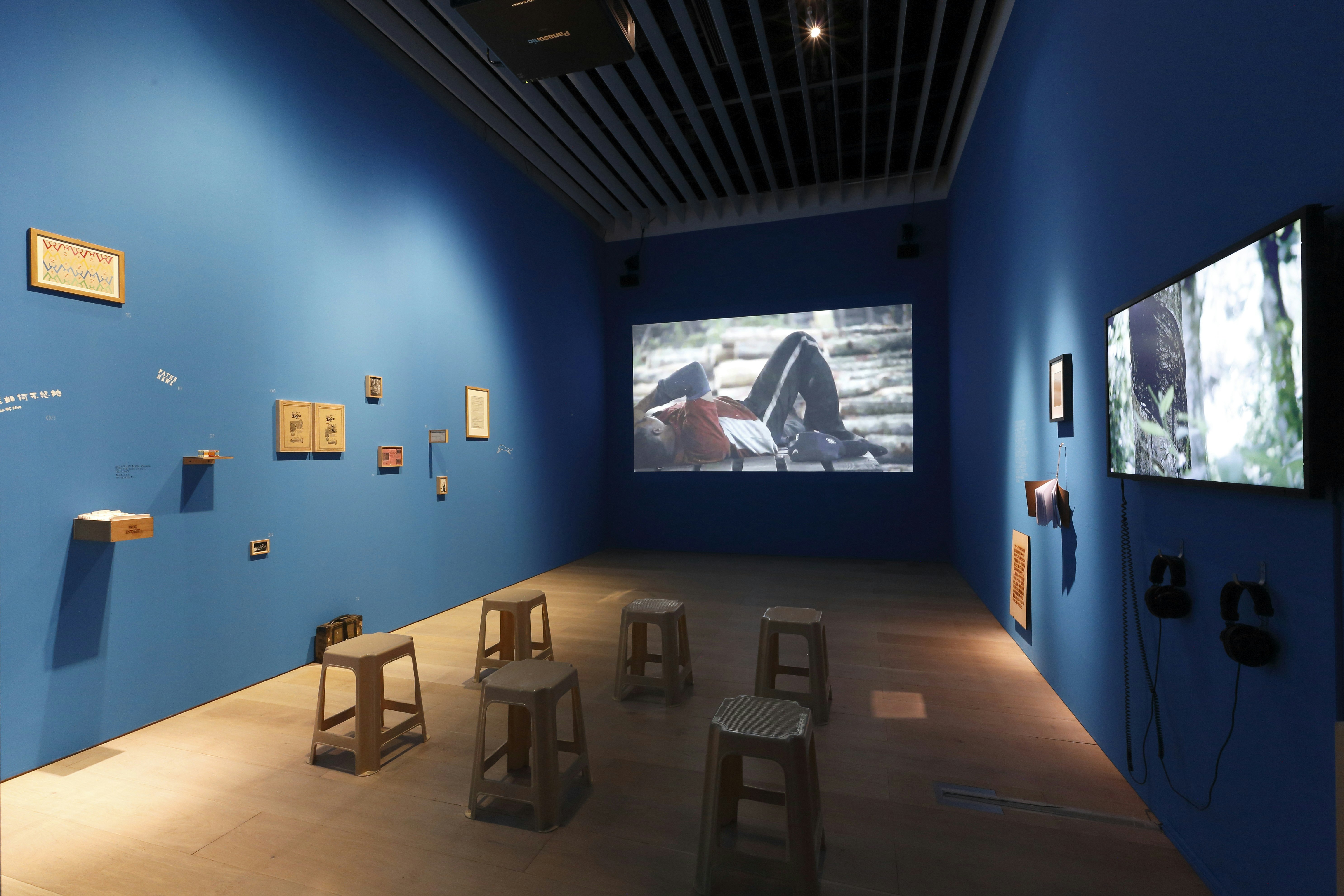
Au Sow-Yee Kris Project I: The Never Ending Tale of Maria, Tin Mine, Spices and the Harimau and To the Party Prelude: Kris Project II 2016 (installation view); photo: Kioku Keizo, SUNSHOWER: Contemporary Art from Southeast Asia 1980s to Now, The National Art Center, Tokyo / Mori Art Museum, 2017, courtesy Mori Art Museum, Tokyo.
Malaysian artist Au Sow-Yee has a practice that defies categorisation. Included in SUNSHOWER is her ambitious Kris Project that began in 2016 and continues her examination of the historisation of Malaysia and Southeast Asia. Her work is suggestive and demanding of her audience. Recasting herself as a fictional male filmmaker named Ravi, and tracking his investigation of found objects from the 1950s and 1960s, Au invites the viewer into post-war Malaysia. Watching fragments of Ravi’s films alongside a collection of found objects the mise-en-scène of Kris Project deftly dissolves the boundaries between fact and fiction. Attempts by the viewer to form neat narratives or locate resolutions are thwarted by red herrings and convoluted tangents that refuse to arrive at a clearly bound statement. Instead, Au challenges her audience to peer into this side-story of history, to piece together the complex post-Cold War politics of the region through sifting through documentation and negotiate a personal construction of history. With the work drifting between memories, archives and imagined moments, the viewer self-consciously seeks to construct a narrative in a futile attempt to pinpoint a linear history and to define truth. It is a critical examination of the complex power structures that riddled the region in the 1950s and 1960s but also must be read as an urgent call for a reimagining and retelling of the region’s history in light of current global concerns. For it is these elusive histories that are sequestered to the sides of history that may be the lessons and forewarnings that contemporary society needs.
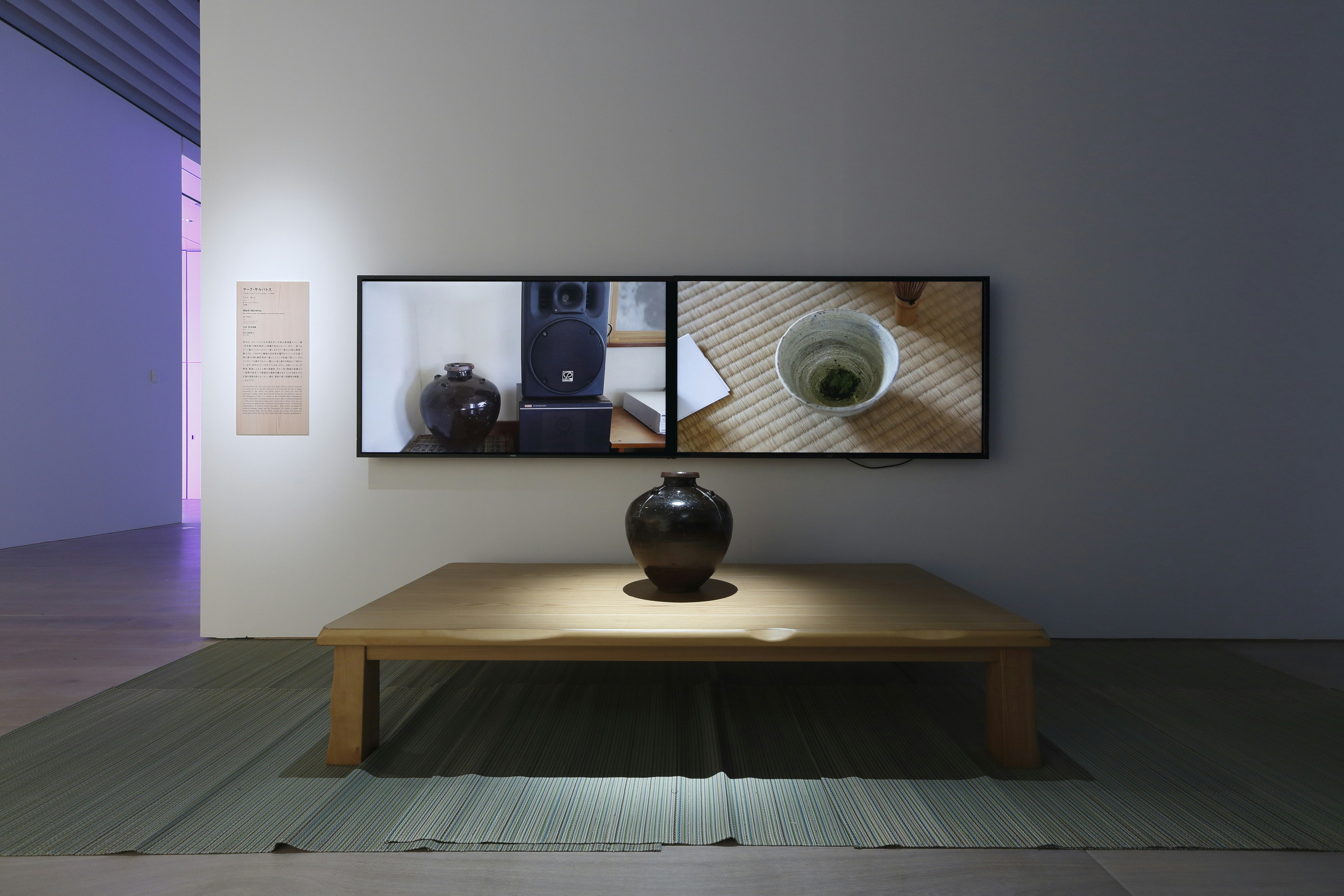
Mark Salvatus, EX / PORT (installation view), 2017, vase, 2-channel video, etc, dimensions variable; photo: Kioku Keizo, SUNSHOWER: Contemporary Art from Southeast Asia 1980s to Now, The National Art Center, Tokyo / Mori Art Museum, 2017, courtesy Mori Art Museum, Tokyo
In a poetic gesture that considers histographies of materiality, Filipino artist Mark Salvatus presented a concise installation comprising a two-channel video accompanied by a pot resting on a low table atop bamboo mats. Ex/Port (2017) was immediately recognisable as a Japanese in aesthetic; natural textures, minimal presentation, and the focus on the materiality of its singular pot. For Salvatus, this found object speaks to the history of Japanese-Filipino engagement that he personifies, now living between Manila and Osaka with his Japanese wife. Happening upon the Luzon pot in Kyoto, Salvatus recasts the object as a metaphor of exchange. Luzon pottery was traded from the port of Agoo on the Filipino island of Luzon to Osaka’s port of Sakai as far back as the sixteenth-century. Since then, trade and exchange has continued from these two locales into contemporary times and in Ex/Port the bustling ports appear alongside each other in the two-channel video. Just below the screens the pot is presented in the manner of museological earnestness, lit with gravitas inferring significance. In Japan, Luzon pottery is a highly regarded object of value while; in the Philippines, it is simply a pot (7). This shift in value that occurs through trade is examined by Sulvatus who sees the trade and exchange of value as critical to our understandings of our histories and futures. It was this dynamic that led to the Philippines being the first Southeast Asian nation colonialised and redirected the course of the country’s history. Furthermore, for Sulvatus the pot’s three-dimensional rendering also defies a single side, or a single story, proving pots to be ‘representations of history with multiple sides, as opposed to how we normally see the past from one perspective’ (8).
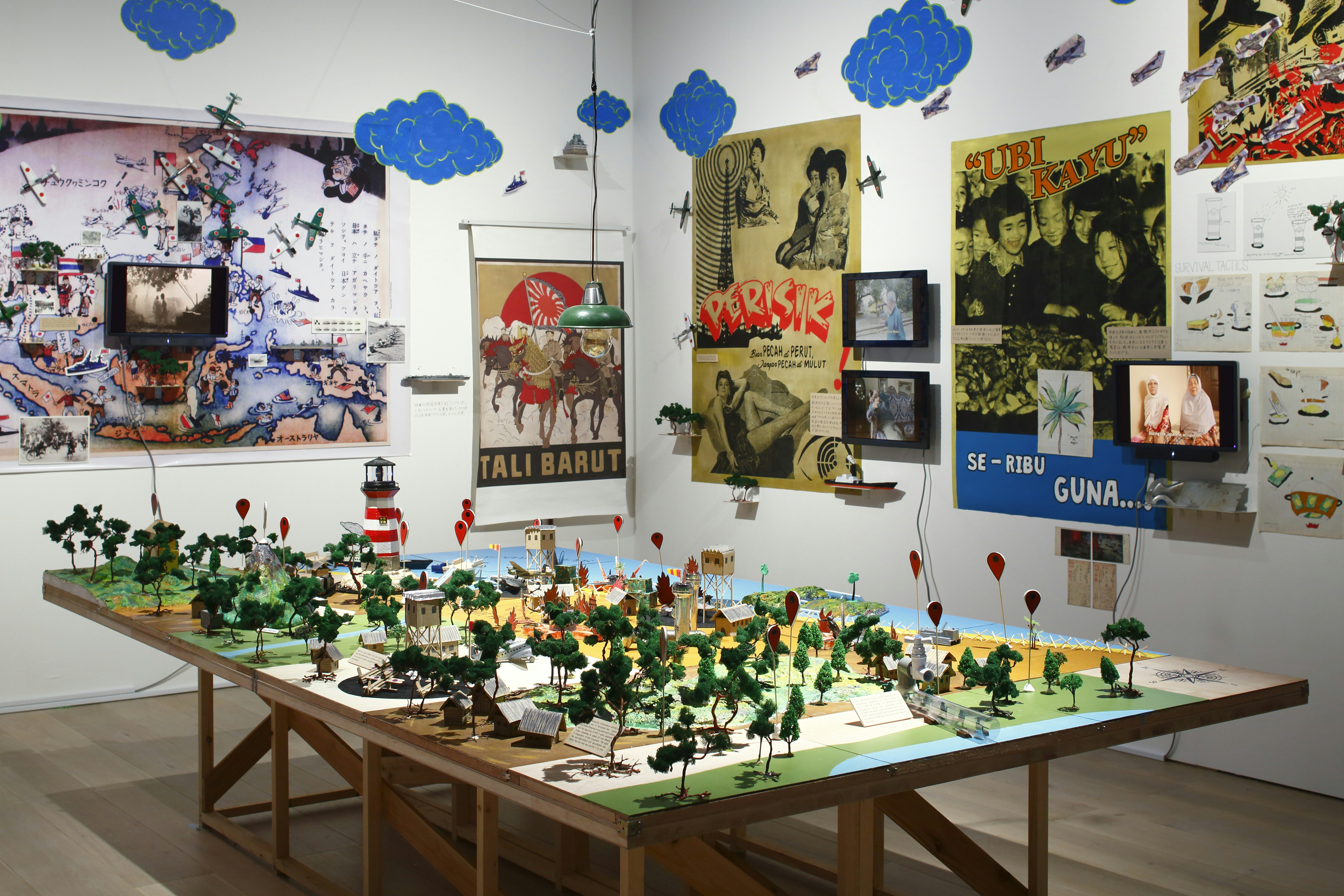
Roslisham Ismail a.k.a. Ise, another story (installation view), 2017, mixed media, dimensions variable; photo: Kioku Keizo, SUNSHOWER: Contemporary Art from Southeast Asia 1980s to Now, The National Art Center, Tokyo / Mori Art Museum, 2017, courtesy Mori Art Museum, Tokyo.
While Au Sow-Yee’s clean and crisp installation begins to delve into the historical trade relations of the region, it is the boisterous work of Roslisham Ismail a.k.a Ise that is the most provocative inclusion in SUNSHOWER. anOther story (2017) is, like the work of Au, a challenge to the viewer. Demanding time to piece together fragments of stories, Ise’s work is a complex historical diorama of the kind that one is more likely to encounter in a history museum. While based in Malaysia, Ise is an astute and prolific artist whose practice centres on an investigation of social relations. Attracted by social anomalies and paradoxes, he seeks to insert himself in fissions of history, networks and contexts as a means to delve into the complexities of social and cultural engagement. For SUNSHOWER, Ise approached the distinct period of 1941-1945 in present day Kelantan on the porous Malaysia-Thai border with unflinching tenacity. This area is his home state and while his work is diligent in its historical research it is the personal underpinning that implicates the viewer when approaching this work. Like Au and Sulvantus before him, Ise seeks to examine a poignant moment of history where it is difficult to ascertain fact from fiction. In anOther story a large diaroma populated by toy soldiers and model trees appears as a complex strategy game but, upon closer inspection, is a reimagining of the topography of the border state. Frozen in time the tableau captures a significant moment in Kelantan’s history where a bourgeoning nationalistic spirit formed from the disintegrations of Japan’s temporary occupation and centuries of British colonial rule. Supported by an assemblage of posters, video and sketches that Ise has both collected and created (informed by interviews with elderly locals), the work becomes increasingly apparent that it is oral traditions and lived memories that capture this period of history in its complexity in a manner that the history books cannot. Ise weaves these stories of espionage, acts of bravery, desperation and survival into taut, political points that form a warning of the political power—and, indeed, of the political tool—that is the act of remembering.
Leaving SUNSHOWER, it is the astute and compelling sentiments of ‘Dialogue with History’ that proves its strongest curatorial statement, one that forms both a warning and a regret in the manner in which the history of Southeast Asia has been relayed and repeated in Japan; a warning that is especially considered in such a large-scale government supported examination of the region through contemporary art. Half a world away in New York’s Upper East Side, the Asia Society’s After Darkness: Southeast Asian Art in the Wake of History was a smaller, focused exhibition that examined the recent history of Indonesia, Myanmar and Vietnam. This exhibition was more visceral and affecting with its particular historical focus being approached through deeply personal artistic practices. The mediation of such massive historic shifts through the lens of the individual makes the viewer complicit in their experience.
Unlike SUNSHOWER’s audience who encountered the exhibition with, as curator Mami Kataoka noted, limited understandings of Southeast Asian modern history, audiences for the more niche Asia Society is well versed in the history of the region and looking for new perspectives (9). With the Asia Society being, much like 4A Centre for Contemporary Asian Art, underpinned by a mission to ‘build bridges of understanding among the people of Asia and the United States’, the exhibition’s curators, Boon Hui Tan and Michelle Yun, have skilfully crafted the show and its accompanying catalogue to not only feature works that speak to the events themselves but also the comprehensive influence they have had on the individual (10). The result is a concise and compelling collection of works that evoke empathy in viewer.
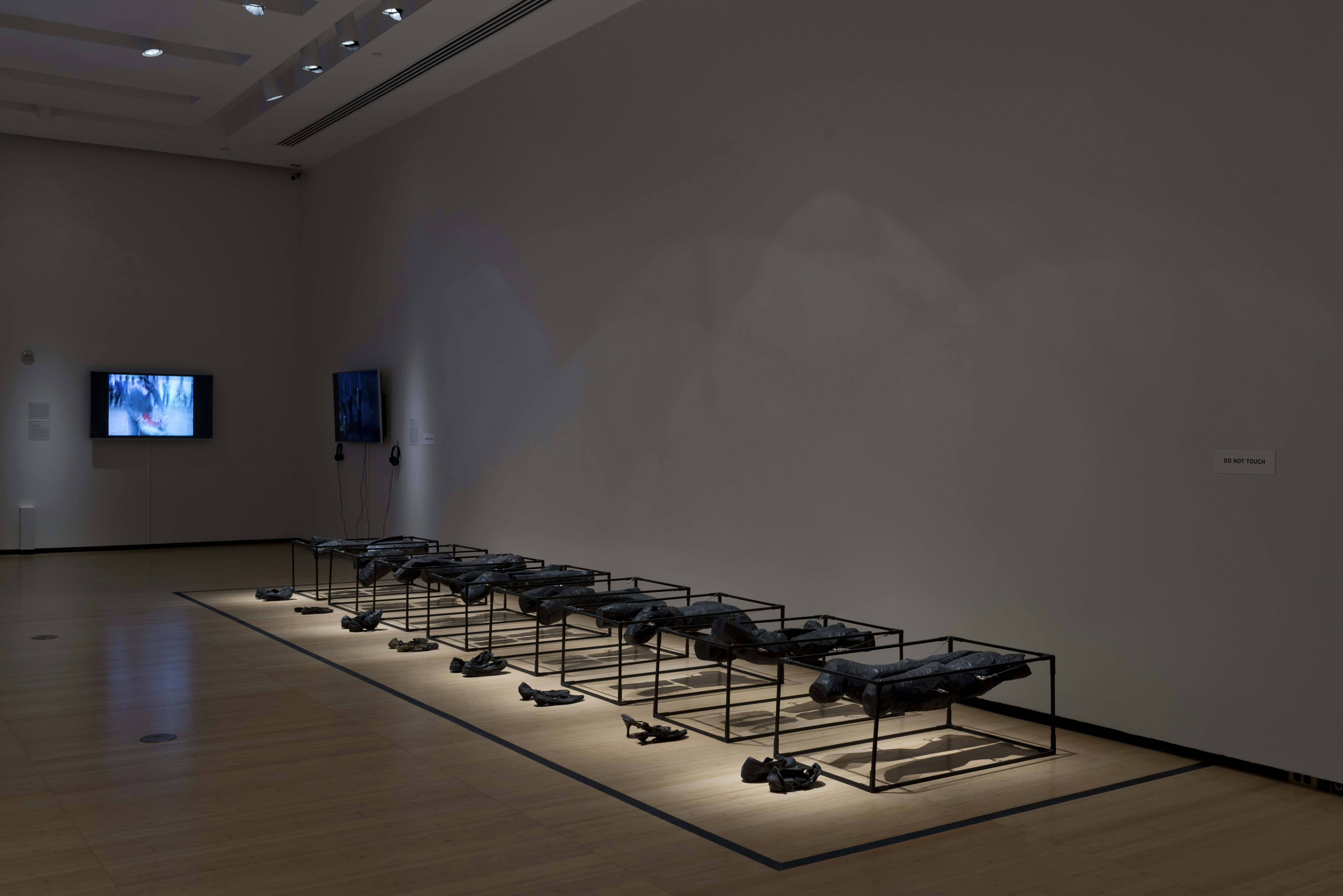
FX Harsono, Burned Victims, 1998, burned wood, metal, shoes, and performance video with sound, dimensions variable; video duration: 8 minutes, 41 seconds, Singapore Art Museum Collection; photo: Perry Hu, courtesy Asia Society Museum
Indonesia’s FX Harsono is a leading artist of his generation, a formidable thinker and a generous and supporting mentor to younger artists. His 2011 series Writing in the Rain will surely come to be widely recognised as a clear masterpiece of the early twenty-first century as it so eruditely encapsulates the complex socio-political and cultural upheavals of contemporary Indonesia. While often curated into survey shows of contemporary Indonesian art in After Darkness Harsono’s practice is represented in depth. The ability to see the grainy footage of his early performance works such as Burning Victims (1998) at Asia Society Museum, that confronts viewers with the remains of charred wood torsos, brings a new impactful dimension to Harsono’s work. There is a rawness about this work that doesn’t translate through documentation. Created during the Reformasi period, the work is a direct response to a violent protest again President Suharto’s authoritarianism where rioters barred the doors of a Jakarta mall locking innocent civilians inside before setting fire to the building.
Harsono’s early 1993 installation The Voices are Controlled by the Powers returns to the Asia Society after first being presented in 1996. This work, like Burning Victims, remains powerfully emotive twenty years later. In a mathematically controlled geometric formation Harsono has placed a series of deconstructed wayang (Indonesian puppetry) masks. Each mask has been disassembled, the jaw sawn off and tossed into a pile, while the remainder of the masks appear in uniform military precision facing their dismembered jaws. It is an eerie metaphoric work that speaks to the Indonesian government’s extensive censorship under Suharto’s New Order regime that spanned the 1960s to late 1990s. Encountering Harsono’s work in New York in such depth enables viewers to develop a more comprehensive understanding of the sustained period of uncertainty that is the lived experience of contemporary Indonesia. Here, Harsono acts as a guide; his work, developed alongside these historical milestones, allows viewers to trace these historic events not through statistics or clipped accounts but through the passion of personal experience.

Htein Lin, A Show of Hands, 2013–present, surgical plaster and multimedia installation, dimensions variable; courtesy the artist.
The visual climax of After Darkness arrived when I entered Htein Lin’s singular room where A Show of Hands (2013-ongoing) dwarfed with its sheer scale. Stretching to the ceiling was rows and rows of plaster of Paris hands, each tagged but all appearing disembodied in a museological display that made me feel that they perhaps took the wrong turn and ended up in collection stacks. Complementing the sculptural works is an archive of documents in nondescript files. Closer inspection revealed the quasi-official records document people who, like Htein, have been political prisoners in Myanmar. Each sculptural hand signifies a life fought for the right to speak.
Born in 1966 into military ruled Burma, Lin came of age as his country sought to negotiate uncertain futures. The first flush of independence was crushed in 1962 with a coup d’état that saw the country become the Socialist Republic of the Union of Burma and, until the dissolution of the military junta in 2011, the majority of Lin’s life had been led in the long shadow of control. Politically engaged by nature, he was expelled from Law School in 1988 for enquiring into the death of a fellow student after which he and fellow activists withdrew to the border of India where they established the All Burma Students’ Democratic Front in opposition to the reigning Burmese military. Returning to Yangon in the early 1990s, Lin completed law school and began actively working as a performance artist until 1998 when he was arrested and imprisoned for six years. It was in prison—devoid of paper, pens and books—that he began to gather stories of his fellow political prisoners.
International media in particular is awash with statistics of horror, where numbers are employed as numbing signifiers of scale for otherwise real confrontations with violence and disasters, too easily converting corporeal experiences into intangible and incomprehensible calculations. A Show of Hands disrupts this tactic, challenging both the viewer to consider the personal trauma and sacrifice that is behind each statistic. With no museum to serve as an epitaph to victims of Myanmar’s civil wars, Lin constructs his own. While his process is one of care and tenderness through the process of wrapping and casting each political prisoners arm there is a moment of constriction. For this short time of constriction, there is a moment of pause while Lin and his subject wait for the plaster to dry and it is in this moment that Lin gleans moments of their time behind bars. Lost dreams, still strong political convictions and hidden wells of hope remain just below the surface of each subject whose story is captured in documents that fill the archive. But it is the sculptures, each an impression of a life lived in duress, that haunt the viewer long after the exhibition. The act of casting is a gesture of healing, a concept that Lin imbued in his work. It is as if through the pseudo-medical act of casting and release there is a soothing of deep-rooted trauma and, importantly, a record of their existence. Lin notes that in the future, when Myanmar returns to stability, these hands will serve as a document of a time not to be forgotten (11).
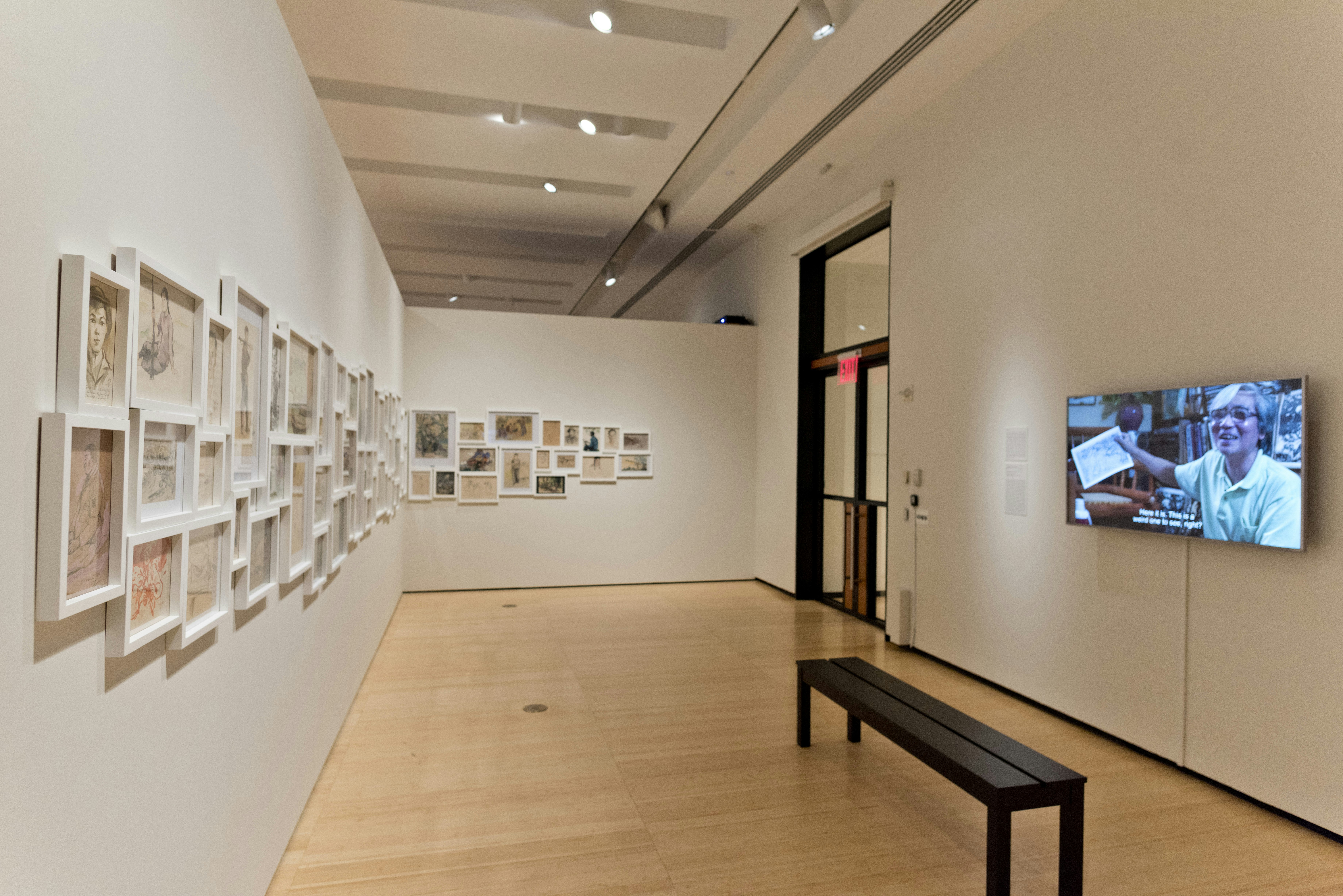
Dinh Q. Lê, Light and Belief: Sketches of Life from the Vietnam War, 2012, 70 drawings in pencil, watercolor, ink, and oil on paper and single-channel video with sound, dimensions variable, video duration: 35 minutes; photo: Perry Hu, Asia Society Museum, courtesy the artist, Shoshana Wayne Gallery, and 10 Chancery Lane Gallery.
This investigation of memory and the construction of history is, for Asia Society’s American audience I suspect, most acutely felt in the work of Vietnamese artist Dinh. Q. Lê. Born in 1968 on the border of Vietnam and Cambodia, Lê is a former refugee who along with his family immigrated to the United States shortly after the end of the Second Indochina War. Returning to Vietnam in 1993, his practice has consistently sought to individualise the complexities of war and the continuing horror of trauma that these generate in a manner that seeks accountability of the political weaponisation of memory. Primarily working in the photographic medium, Lê has agitated for a multiplicity of approaches and understandings of American-Vietnamese combat.
For After Darkness Lê exhibited the powerful curatorial research-based series, Light and Belief: Sketches of Life from the Vietnam War (2012) that comprise a collection of drawings and watercolours produced by North Vietnamese soldiers during battle. Sketched in quiet moments, each vignette offers an insight into the hopes and anxieties of young men caught in a war beyond their control (12). The drawings do not depict battles but rather serve as mementos, personal reflections that reveal the individual’s longings and wants beyond the battlefields. Shown alongside these is a video of interviews that Lê conducted with the now elderly soldier artists. Speaking with passion tinged with loss, the reality of their experience—voices rarely heard in America—becomes emotively relatable. Far from the monstrous propaganda depicted by both sides, Lê’s curatorial assemblage enables viewers to identify with the humanity in the so-called enemy, thereby potentially recasting entrenched understandings of history. Through such a retelling Lê actively seeks to engage a more complex and meaningful understanding of history, one that not only interrogates the role of America in the Second Indochina War but also, and perhaps more importantly, the manner in which we remember.
While both SUNSHOWER and After Darkness represent important presentations of contemporary art from Southeast Asia, as cultural projects undertaken by important museums in Tokyo and New York they are themselves multilayered examinations of contemporary relations between Japan and the United States of America. Through their curatorial investigations of a diverse and dynamic region they present differing and valuable perspectives on complex historical relationships while at the same time look forward to futures built on collaborative understandings.
Notes
(1) Victor T. King, ‘Southeast Asia’ in Southeast Asia: a historical encyclopaedia from Angkor Wat to East Timor, edited by Ooi Keat Gin. (Santa Barbara, California: ABC Clio, 2004) 1232.
(2) While there were several treaties between Thailand and Japan throughout the Second World War, such as the short-lived 1940 Treaty between Thailand and Japan Concerning the Continuance of Friendly Relations and the Mutual Respect of Each Other’s Territorial Integrity, the following year’s treaty of mutual alliance that was written but not signed by or delivered to key parties meant that the façade of allegiance was little more than a less violent occupation. For access to the full text of the treaties and their contexts see: Douglas M. Gibler, International Military Alliances 1948-2008 (Washington D.C.: CQ Press, 2008).
(3) There are no confirmed numbers of deaths that were incurred as part of the Second Indochina War but estimates rangen up to 4,200,000 people lost their lives. For example, Death Tolls for the Mahor Wars and Atrocities of the Twentieth Century – The Vietnam War. Accessed 20 April 2018.
(4) Statement on the Mori Art Museum. Accessed 20 April 2018.
(5) ‘Foreword’ in Sunshower: contemporary art from Southeast Asia 1980 – now, ex. cat. (Tokyo: Heibonsha Ltd, 2017) 11.
(6) Mami Kataoka, ‘Sunshowers in Southeast Asia: a premise for an exhibition’ in Sunshower, op. cit, 276.
(7) Mark Salvatus quoted by Chloe Chu, ‘Serendipity and the streets: interview with Mark Salvatus’ in ArtAsiaPacific Blog, 16 October 2017. Accessed 20 April 2018.
(8) Ibid.
(9) Kataoka, op. cit., 276.
(9) Josette Sheeran, ‘President’s foreword’ in After darkness: Southeast Asian art in the wake of history, ex. cat. (New York: Asia Society, 2017) 6.
(11) Htein Lin, ‘Hands tell the story’. Accessed 20 April 2018.
(12) Caroline Turner and Jen Webb, ‘War violence and divided societies’ in Art and human rights: contemporary Asian context. (Oxford, U.K.: Oxford University Press, 2016) 101.
About the contributor
Mikala Tai was the director of 4A Centre for Contemporary Asian Art, Sydney from 2015 — 2020.
